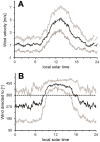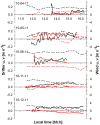Maintenance of coastal surface blooms by surface temperature stratification and wind drift
- PMID: 23593127
- PMCID: PMC3623857
- DOI: 10.1371/journal.pone.0058958
Maintenance of coastal surface blooms by surface temperature stratification and wind drift
Erratum in
- PLoS One. 2013;8(6). doi:10.1371/annotation/a2f49bbd-e226-4a15-900a-5946cff07d75
Abstract
Algae blooms are an increasingly recurrent phenomenon of potentially socio-economic impact in coastal waters globally and in the coastal upwelling region off northern Baja California, Mexico. In coastal upwelling areas the diurnal wind pattern is directed towards the coast during the day. We regularly found positive Near Surface Temperature Stratification (NSTS), the resulting density stratification is expected to reduce the frictional coupling of the surface layer from deeper waters and allow for its more efficient wind transport. We propose that the net transport of the top layer of approximately 2.7 kilometers per day towards the coast helps maintain surface blooms of slow growing dinoflagellate such as Lingulodinium polyedrum. We measured: near surface stratification with a free-rising CTD profiler, trajectories of drifter buoys with attached thermographs, wind speed and direction, velocity profiles via an Acoustic Doppler Current Profiler, Chlorophyll and cell concentration from water samples and vertical migration using sediment traps. The ADCP and drifter data agree and show noticeable current shear within the first meters of the surface where temperature stratification and high cell densities of L. polyedrum were found during the day. Drifters with 1m depth drogue moved towards the shore, whereas drifters at 3 and 5 m depth showed trajectories parallel or away from shore. A small part of the surface population migrated down to the sea floor during night thus reducing horizontal dispersion. The persistent transport of the surface bloom population towards shore should help maintain the bloom in favorable environmental conditions with high nutrients, but also increasing the potential socioeconomic impact of the blooms. The coast wise transport is not limited to blooms but includes all dissolved and particulate constituents in surface waters.
Conflict of interest statement
Figures










References
-
- Hallegraeff GM (1993) A review of harmful algal blooms and their apparent global increase. Phycologia 32: 79–99 doi:10.2216/i0031-8884-32-2-79.1. - DOI
-
- Lewitus AJ, Horner R, Caron D, García-Mendoza E, Hickey BM, et al. (2012) Harmful algal blooms along the North American west coast region: History, trends, causes, and impacts. Harmful Algae 19: 133–159 doi:10.1016/j.hal.2012.06.009. - DOI
-
- Gilbert P, Burkholder J (2006) The complex relationships between increases in fertilization of the earth, coastal eutrophication and proliferation of harmful algal blooms. In: Granélli E, Turner JT, editors. Ecology of Harmful Algae. Berlin: Springer. 341–354.
-
- Hinder S, Hay G, Edwards M, Roberts E, Walne A, et al. (2012) Changes in marine dinoflagellate and diatom abundance under climate change. Nature Climate Change 2: 271–275 doi:doi:10.1038/nclimate1388. - DOI
-
- Anderson DM, Cembella AD, Hallegraeff GM (2012) Progress in Understanding Harmful Algal Blooms: Paradigm Shifts and New Technologies for Research, Monitoring, and Management. Annual Review of Marine Science 4: 143–176 doi:10.1146/annurev-marine-120308-081121. - DOI - PMC - PubMed
Publication types
MeSH terms
Substances
LinkOut - more resources
Full Text Sources
Other Literature Sources
Molecular Biology Databases

